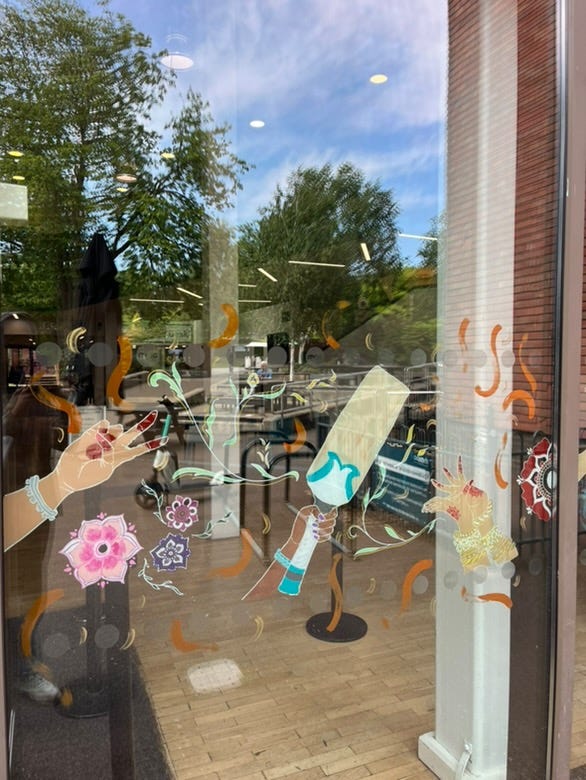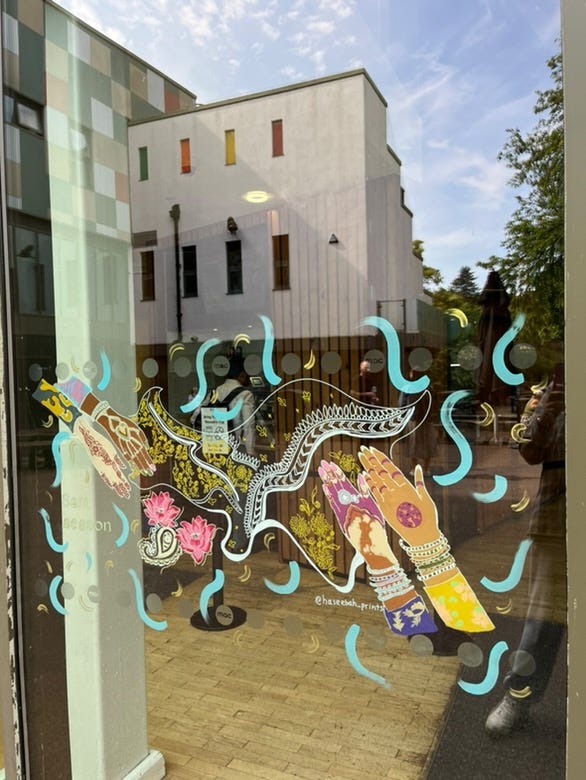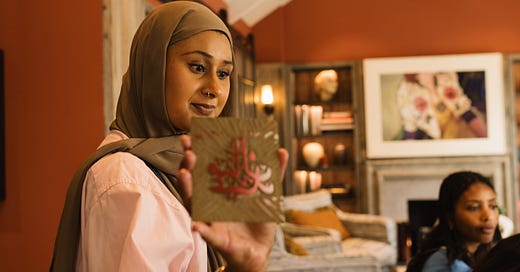Community Spotlight: Printmaking with Haseebah Ali
The first of our Community Spotlight series with artist and arts educator, Haseebah Ali
Editor’s note: Salaam!
We are so excited to share the first of our new Substack series, Community Spotlight, where we talk to some of our favourite Muslim creatives about their work and their creative journeys.
We loved chatting to Haseebah for the first edition of this series, and we were totally inspired by learning about her craft and her journey and hope you do too. Look out for more of our Community Spotlight series in the coming months <3
“For me, it’s being able to share my voice and advocate for myself, my culture and my community. I find it all very endearing especially with how Muslim artists are being unapologetically Muslim and refusing to be tied down to a box or stereotype based on how society perceives them. It means that finally people are seeing us as individuals with our own styles and interests.”
Through her work, Birmingham-based print artist and arts educator Haseebah Ali has explored a rich tapestry of stories and histories from across the Muslim diaspora – spotlighting narratives from Syrian, Pakistani, Persian and Moorish cultures, to name just a few.
As part of our early Eid al-Adha celebrations, the Muslim Sisterhood team had the pleasure of co-hosting a workshop with Haseebah. Inviting friends from our creative community to Bicester Village, we gathered to learn about the lino printing process and tried our hand at making our own prints and creating Eid cards.
As long-time fans of Haseebah’s work, we were excited to pick up some lino printing skills (or sharpen them, for some of the more experienced) but the workshop exceeded even our own expectations. The afternoon took its own slow & meditative pace, as we got into the groove of carving out our personal designs. Before we even realised, two hours quickly turned into four, as we embraced the mindful practice of lino cutting and played around with different colour combinations as we got to printing, all under Haseebah’s expert and patient guidance.
Feeling super inspired after the workshop, we were eager to spend more time with Haseebah and ask some more personal questions about her craft and her journey. We chatted about her entry into printmaking, how her practice has evolved and what it means to be Muslim woman within the arts community.
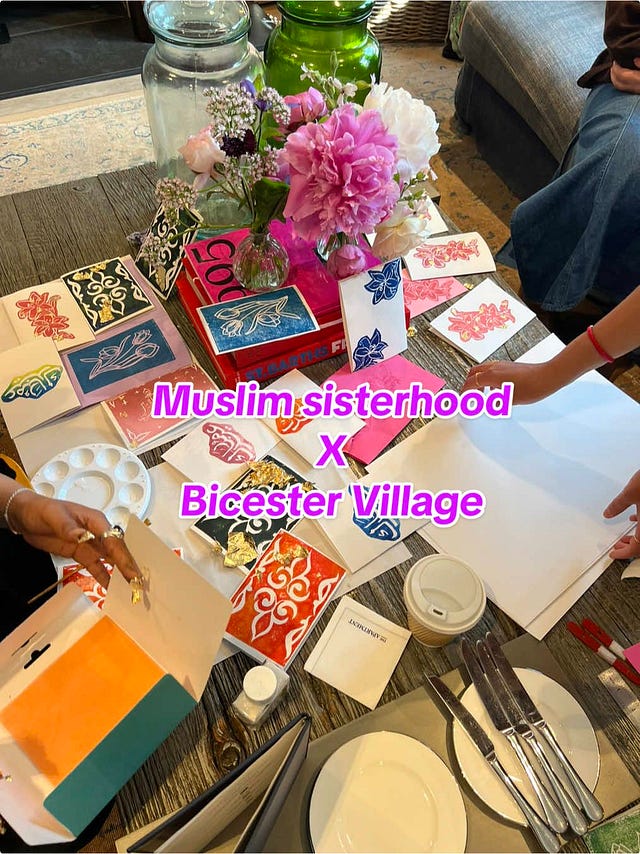
 Tiktok failed to load.
Tiktok failed to load.Enable 3rd party cookies or use another browser
I wanted to start off by asking about your artistic background and your journey so far. How did you first discover printmaking and what is it about the craft that drew you to it?
I first discovered printmaking through my college art teacher. I remember her teaching me reduction lino print and it was my first time dealing with an old school press as well so everything was new to me. I remember how I didn’t really understand the process but I just went along with it and ended up falling in love. The thing that drew me in was the unpredictability of it and just how process driven printmaking is in general. It transports you to another world when you’re carving or preparing a plate, I would describe it as quite therapeutic.
A lot of your work is inspired by Islamic Art from across the Muslim diaspora - from henna designs to Persian rugs. How do you choose your sources of inspiration and what types of stories and histories spark inspiration for you?
My sources of inspiration are mainly through stories. I love weaving narrative into my work so whenever I think of a specific voice or story I want to amplify I think of the colours and imagery that might go with it. An example of this is the project ‘Found Cities’ with BMAG and Southbank centre. The brief was women roaming the city, and for me it was about the restriction of the city from day to night and how that affected how I could travel. Through this I used light peaches deepening into fuchsias and deep purple to represent day to night, and an Islamic geometric design as a map to show how women roam the city streets, and often how we have to take the longer yet ‘safer’ route to get home. I mainly love telling stories that need to be spoken about more and educate me and the audience that views it.
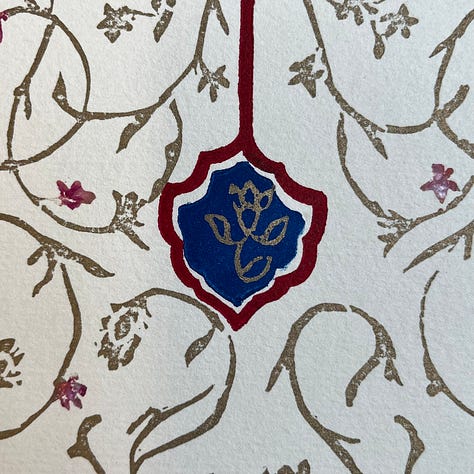
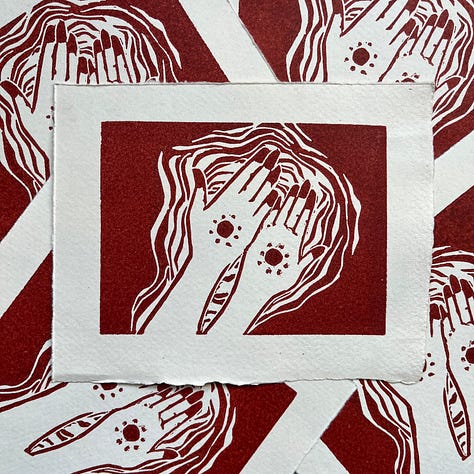
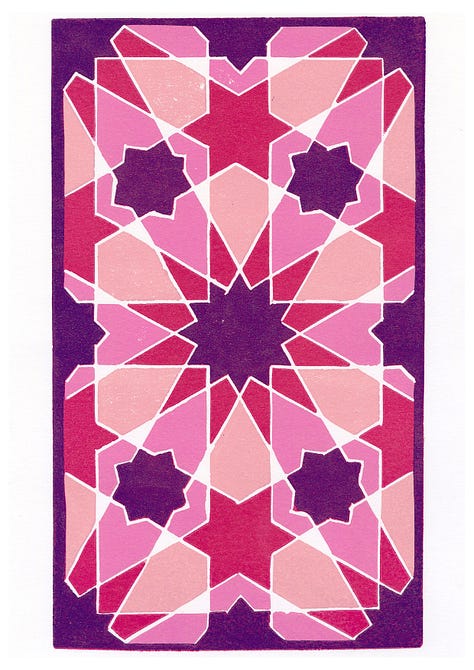
Along with storytelling, fundraising is deeply intertwined with your work, starting off with your ‘Syrie’ project to raise awareness for the Syrian refugee crisis and has since expanded to raise funds for Palestine and Congo. Can you tell us more about how this started and why it has become so important to your practice?
Syrie was my final major project in my last year of university so it’s very dear to me. I started out with seeing the Syrian refugee crisis on the news and that particular harrowing scene of one young boy being washed up on the shore.
I remember when I went back to university and was speaking about it, no one knew of the crisis or what was happening on the news. It made me think about how much privilege there is in being ignorant of daily politics and how helpless I felt. From this I did a deep dive into the crisis and wanted to illustrate how these are people, not just numbers or boats that we can ignore or stigmatize.
I also felt uncomfortable on profiting on the prints as it felt exploitative of the crisis and the Syrian people which made me want to donate 50% of all proceeds to a charity aiding Syrian refugees. I changed this to 100% a few years back and I’ve now raised and donated just over £800. It’s gratifying to think your artwork can make a difference, and I’m a big believer of whatever good you give out in the world, you get back. Charity is such an important pillar in Islam so I just feel lucky that I’m able to achieve that through my artwork, and now it’s so integral to how I navigate my art practise.
As we start to see more Muslim artists emerge, what does it mean to you to be able to showcase your culture and community through your art?
For me, it’s being able to share my voice and advocate for myself, my culture and my community. I find it all very endearing especially with how Muslim artists are being unapologetically Muslim and refusing to be tied down to a box or stereotype based on how society perceives them. It means that finally people are seeing us as individuals with our own styles and interests. The women in my family have all been very creative, but they never got the chance to explore that side to them fully and received the opportunities that I have, so I feel like I’m doing it for myself but also all the young girls before me and it’s such a privilege to be able to do that through art.
Beyond your printmaking, you also run a lot of workshops for different communities - we briefly chatted on Monday about the work that you do with a whole range of groups, from library groups to working with kids and with older people. How do these experiences differ and what do you learn from these more educational roles?
With the younger groups I can make the sessions quite playful and it’s more about the process rather than the final outcomes. As artists sometimes we’re so focused on the end product that we rarely savour how we got there so with the younger children they remind me to have fun and let go, and really enjoy the process. I also love working with older groups especially more mature women as I feel like I’ve learnt so much from them. They’re always so kind and considerate and the conversations that happen within these spaces are truly the warmest. It’s always quite funny when I arrive because they feel like I’m too young to teach them, but slowly you see the trust start to build and it’s a beautiful process. I love hearing their stories and their advice and truly appreciating the artistic talent that is embedded in them.
Last year you were granted the Developing Your Creative Practise fund by Arts Council England, which is a huge achievement, Mashallah. How were you able to expand and evolve practice with this funding? What were the best learnings from this process?
Finances has always been a barrier for me especially with being working class and full time self employed. You either have the money but you’re too busy or have the time but too broke. The funding allowed me to experiment more, attend workshops like Japanese woodblock printing and paper making and really indulge in new art materials.
For a while before the funding I always stuck to lino or chose the safest option which stunted my growth so to be able to just figure a new material out and not worry about ‘ruining’ or ‘wasting’ the materials was great. Also I had the opportunity to visit the south of Spain and see all the Islamic Art and architecture, and it taught me just how influential Muslim artisans are and how much they’ve influenced other art styles.
I’m sure that many of our readers will find your story super inspiring so my final question to you would be: what words of advice would you give to young Muslim women who want to break into the arts?
I’d say to just show what you’re doing, keep making work for the sake of making and be in the art spaces. Invest in your local area and what the creative community is like there. They’re going to be way more interested in you than anyone else because you know the community and you’re from the community. Even if it’s attending a show or a workshop just to be present and say hello, you never know what might come out of that.
You’ll next be able to catch Haseebah’s work at the Ort gallery at MIAH foundation from the 10th July- 14th August, in a show focusing on the Azad Kashmiri community in the UK where Haseebah will be showcasing work that focuses on the craft and labour of her family.
You’ll also be able to see a mural by Haseebah at the Midlands Art Center as part of The Offbeat Sari Exhibition, which is on until mid November.
